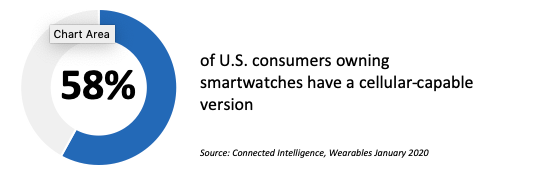
Huawei GT 2 Series
As expected, Huawei announced the GT 2 and GT 2e smartwatches this past week. Pricing is aggressive, starting at just EU 199 for a watch that is packed with goodies. The “e” version is particularly interesting as it’s aimed at a more youthful audience: the sports tracking modes (100 in total!) include skateboarding, rock climbing and even parkour for the particularly agile wearer. With a battery life of up to two weeks, a beautiful form factor and all the usual health monitoring functionality, the Huawei device looks like a strong contender.
The NPD Take:
- There’s no cellular option for the GT 2 series, which helps to explain the long battery life. It makes sense as any Huawei device with cellular will hit “complications” in some countries these days – such as the US, but still, it’s a major miss for the device.
- A well-designed watch, with a great form factor and a low price. This watch will do very well… outside the US of course.
Another Luxury Watch
Announcements are still slowly rolling out after what should have been Baselworld 2020, the luxury watch show in Switzerland. The latest launch is the Tissot T-Touch Connect Solar from Swatch. The watch runs on Swatch’s proprietary OS and can work with iOS, Android or Huawei’s Harmony OS – in a nod to the importance of the Chinese market. As the watch’s name suggests, it comes with solar charging which promises an extended battery life of up to six months.
The NPD Take:
- Details of the watch are still coming out, but the battery life of six months is a major improvement compared to other devices. Of course, it’s not clear if GPS is included in the watch, and how that will impact the overall battery life. Having said that, for customers looking for an elegant watch that provides the usual array of smartphone notifications, this looks appealing.
- At $1000 this is hardly a cheap watch. But then again, it’s not supposed to be: it’s a Tissot. For customers that like the brand, price won’t be an issue.
Warning Ring
In the midst of the COVID-19 pandemic, researchers in California are exploring whether wearables can provide an early warning that health care workers may be infected. A key wearable product that is being tested is the Oura Ring, which primarily tracks sleep patterns and – importantly – the wearer’s temperature. But the research is considering a wide range of wearables including Apple Watch, Fitbit and others to try and predict regional clusters of the virus using data on heart rate, activity, temperature and sleep levels.
The NPD Take:
- Wearables have long had a health-related aspect, rather than just fitness, and while this is a novel use case, it’s clearly a very important one.
- Most wearables do not track temperature – a key metric for detecting COVID-19 – and this helps Oura to stand out from the pack. Which is important as the device has limited functionality compared to smartwatches and trackers. If the ring proves to be of use, we can expect to see a lot more people wearing the ring, as well as a smartwatch.